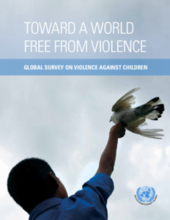The Global Survey on Violence against Children, conducted under the auspices of the Special Representative of the Secretary General on Violence against Children, examines the measures in place around the world to ensure follow-up to the recommendations set out in the 2006 UN Study on Violence against Children, especially those recommendations intended to prevent violence against children, protect child victims and hold perpetrators to account. It draws on a wide range of sources, including the responses from 104 governments to the Global Survey questionnaire, which was shaped by the UN Study recommendations. A child-friendly version of the Global Survey questionnaire was developed and disseminated, and seven regional consultations were held with children and young people between 2009 and 2012, spanning West Africa, the Caribbean, Central America, South America and South Asia. The Survey reveals that there has been some progress on these issues since the 2006 study, but “this progress has been too slow, too uneven and too fragmented to bring violence to an end”.
The report looks into both the risk factors explaining why violence against children remains prevalent and examines how these factors apply to a number of settings such as schools, their homes, alternative care and others. It also delves into methods and practices aiming at strengthening protection policy frameworks and preventative mechanisms and programs. The Global Survey underlines that all children are at risk of violence, but the most vulnerable children are those at greatest risk of violence: those with disabilities, those who migrate, those who are confined to institutions, and those whose poverty and social exclusion expose them to deprivation, neglect and, at times, to the inherent dangers of life on the streets.
Chapter 3 of the report addresses violence against children in all settings, including home and the family as well as care and justice institutions. It highlights violence in alternative care institutions as a matter of specific urgency. It reports that children in care, already facing vulnerabilities due to their circumstances, are at a high risk of violence, abuse, and neglect from the caregivers and that little progress has been made toward addressing this. Pointing to research in the CEE/CIS region, it highlights that children with disabilities face a greater risk than others of being institutionalized and of staying so for long periods. The report argues that such violence can be more effectively prevented when institutional care can be avoided where possible and where families can be supported to care for their children at home. It stresses the important role of the 2009 Guidelines for the Alternative Care of Children in that regard, which sets out desirable pathways for policy and practice on the protection and well-being of children deprived of parental care or who are at risk of being so. It also underlines that the situation of all children in institutions is addressed most effectively by strategies that go beyond the institutional setting to ensure that families and caregivers receive support to care for their children at home where possible, to help schools adopt inclusive teaching techniques and provide appropriate support for all children, and to create a protective community environment for these children.

